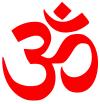| Part of a series on |
| Hindu scriptures and texts |
|---|
 |
| Related Hindu texts |
Tantrāloka (Sanskrit: तन्त्रालोक, romanized: tantrāloka, lit. 'Elucidation of Tantra') is a treatise of Abhinavagupta, a writer and philosopher of the Kashmir Shaivism school of Hindu philosophy.
YouTube Encyclopedic
-
1/3Views:1 8364 27229 167
-
Kashmir Shaivism: part 1. Abhinavagupta's Tantrāloka: v.4181b 183 by Boris Marjanovic
-
Kashmir Shaivism: Parts 1and 2 of Abhinavagupta's Tantrāloka 4:181b-183 by Boris Marjanovic
-
Principles and Practices of Kashmiri Shaivism - Sanskrit Texts
Transcription
Overview
The work contains the synthesis of the 64 monistic āgamas and the different schools of tantra. It discussed both ritualistic and philosophic aspects in 37 chapters; the first chapter contains the essential teachings in condensed form. On account of its size and scope it is considered an encyclopedia of the nondual school of Hindu tantra. A more abridged and concise version of the Tantrāloka, also written by Abhinavagupta, is the Tantrasāra.
Tantrāloka was written in the 10th century and gained greater worldwide prominence towards the end of the 19th century with the publishing and distribution of the Kashmiri Series of Texts and Studies and prominence of Swami Lakshmanjoo, who taught the text and its oral tradition to scholars and seekers alike.[1]
Its complete translation into Italian, edited by Raniero Gnoli, is now at its second edition.[2] The esoteric chapter 29 on the Kaula ritual was translated in English together with Jayaratha's commentary by John R. Dupuche.[3] In 2023, Mark Dyczkowski published a complete translation into English with Jayaratha's commentary.[4]
A complex study on the context, authors, contents and references of Tantrāloka was published by Navjivan Rastogi, Prof. of the Lucknow University.[5] The last recognized master of the oral tradition of Kashmir Shaivism, Swami Lakshmanjoo, gave a condensed version of the key philosophical chapters of Tantrāloka in his book, Kashmir Shaivism: The Secret Supreme.[6] These chapters cover the: 36 elements (tattvas), six paths (ṣaḍadhvan), four means of realization (upāyas), three impurities (malas), states and processes of the seven perceivers (pramātṛin), five acts of Śiva including his grace (śaktipāta), five states of the individual subjective body, seven states of turiya, fivefold contacts of masters and disciples, various modes of Kuṇḍalinī rising, and the theories of the alphabet (mātṛikācakra), reflection (pratibimbavādaḥ), liberation (mokṣa), and speech (vāk), along with discussions about the origins of the tantras and the differences between Kashmir Śaivism and Advaita Vedānta.[6]
References
- ^ Sanderson, A. (2011). "Saṃvidullāsaḥ: manifestation of divine consciousness: Swami Lakshman Joo, saint-scholar of Kashmir Śaivism, a centenary tribute". In Bäumer, B., Kumar, S. (eds.). Swami Lakshman Joo and His Place in the Kashmirian Śaiva Tradition. D.K. Printworld. pp. 93–126. ISBN 978-81-246-0414-4.
- ^ Luce dei Tantra, Tantrāloka, Abhinavagupta, Raniero Gnoli, 1999
- ^ Dupuche, John R. The Kula Ritual as Elaborated in Chapter 29 of the Tantrāloka of Abhinavagupta.
- ^ Dyczkowski, M. S. G. (3 March 2023). TANTRALOKA THE LIGHT ON AND OF THE TANTRAS - VOLUME ONE: Volume One - Chapter One, With the Commentary called Viveka by Jayaratha, Translated with extensive explanatory notes. Independently published. ISBN 979-8-3761-3921-9.
- ^ Introduction to the Tantrāloka, Navjivan Rastogi
- ^ a b Kashmir Shaivism – The Secret Supreme, ed, John Hughes, SUNY press, 1985.
Sources
- Mukund Rām Shāstrī, ed. (1918). The Tantrāloka of Abhinava Gupta. Vol. 1. Commentary by Rājānaka Jayaratha. Allahabad: Indian Press.
- Abhinavagupta's Shri Tantraloka. English translation. Standard Publishers 2015.
{{cite book}}: CS1 maint: others (link) - Abhinavagupta; Dvivedī, Rāmacandra; Rastogī, Navajīvana (1987). Tantrāloka : with the commentary of Jayaratha / 1 Introduction. Delhi: Motilal Banarsidass. ISBN 81-208-0241-1. OCLC 165479173.
- Tantraloka – The Light on and of the Tantras (2023, self-published at Varanasi) by Abhinavagupta. Vol. I: ISBN 979-8-3761-3921-9. Vol. II: ISBN 979-8-3791-7463-7. Vol. III: ISBN 979-8-3791-7555-9. Vol. IV ISBN 979-8-3857-0571-9. Vol. V. ISBN 979-8-3899-6389-4. Vol. VI. ISBN 979-8-3899-6449-5. Vol VII. ISBN 979-8-3960-5383-0. Vol VIII. ISBN 979-8-3976-0356-0. Vol IX. ISBN 979-8-8522-8502-7. Vol X. ISBN 979-8-8522-8570-6. Vol XI. ISBN 979-8-8522-8637-6.
